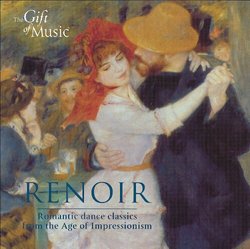| All Artists: Various Title: Renoir Members Wishing: 0 Total Copies: 0 Label: The Gift of Music Original Release Date: 1/1/2003 Re-Release Date: 3/3/2005 Genre: Classical Styles: Opera & Classical Vocal, Ballets & Dances, Ballets, Forms & Genres, Concertos, Historical Periods, Modern, 20th, & 21st Century, Symphonies Number of Discs: 1 SwapaCD Credits: 1 UPC: 658592106329 |
Search - Various :: Renoir
 | Various Renoir Genre: Classical
RenoirRomantic dance classics from the Age of Impressionism The magic of the dance in music, with an emphasis on Paris towards the end of the nineteenth century. Orchestral works by Ravel ('La Valse'), Offenbach, Berlioz a... more » |
Larger Image |
CD Details
Synopsis
Product Description
RenoirRomantic dance classics from the Age of Impressionism The magic of the dance in music, with an emphasis on Paris towards the end of the nineteenth century. Orchestral works by Ravel ('La Valse'), Offenbach, Berlioz and others capture the mood of Renoir's beautiful portrait of dancers. Music for dancing and dreaming. 'Why shouldn't art be pretty? There are enough unpleasant things in the world.' Pierre Auguste Renoir Renoir is perhaps the best loved of all the Impressionists, for his subjects - pretty children, flowers, beautiful scenes, and lovely women - have an instant appeal. Renoir loved to paint the female form and specialised in capturing on canvas beautiful women, becoming particularly adept at painting exquisite skin tones. He began his artistic career as a painter in a porcelain factory, where he began to understand the effect of light on surfaces, and how to create an effective and appealing palette of colours for a painting, as well as learning to be an effective draughtsman. His pre-occupation with essentially light-hearted subjects, such as the 'Dance at Bougival' may have been influenced by the great masters of the Rococo period, whose paintings he frequently studied in the Louvre art gallery. He became a friend of Monet and Sisley, spending time with them in the cafés of Paris and discussing art and painting with them, as the Impressionist movement developed and became a clearly recognised style and technique. Like many artists, Renoir was very hard up at first, and financial success came only later in his life, when eventually a Parisian dealer began selling his works for him. As his fame grew, so he shied increasingly away from his light-hearted style, and began to create works in more sombre colours, turning very late in his life to sculpture, although rheumatism prevented him from working with materials himself and he worked instead through assistants whom he instructed to act as his hands. This collection of music reflects some of Renoir's artistic preoccupations. The music is a mixture of the serious and the light-hearted, but all showing an overwhelming degree of craftsmanship, and of pure technical skill on the part of its composer. The music of Jacques Offenbach is a case in point. Offenbach had technical skill which was the equal of any composer of his time, and a gift for melody which is quite breath-taking. But rather than use those talents on serious opera, or grand symphonic works, the lithe musicianship of Offenbach was put to the service of popular theatre. The overture to 'La Vie Parisienne' is easy-going and bubbly, but it is perfectly executed, and every bar of the score shows the hand of a master composer. Hector Berlioz was a master of the orchestra, capable of manipulating huge forces with an ease which defies belief. His 'Symphonie Fantastique' presents a story in music, each movement sharing the same underlying musical theme, which in the case of 'Un bal' is transformed into a passionate waltz. Maurice Ravel, from a later Parisian artistic generation, wrote inspiring music. 'La valse' is testimony to his fascination and mastery of the dance form, as, perhaps surprisingly, is the opening 'Allegremente' of his G major piano concerto, which trips along in exuberant style. Saint-Saëns, Rossini and Bizet were all master communicators of infectious, happy music, while Tchaikovsky's dance music, composed for the ballet, remains virtually unsurpassed in its musical perfection, style and approachability.

 Track Listings (10) - Disc #1
Track Listings (10) - Disc #1